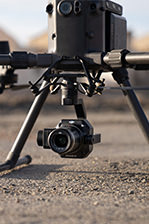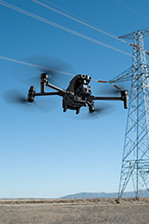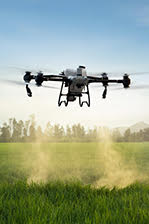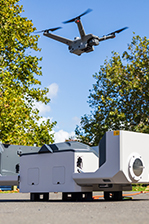DJI Transmission (Standard Combo)
DJI Transmission incorporates O3 Pro video transmission technology, which offers an incredible 6km/20,000ft on-ground transmission distance. It also supports transmission at 1080p/60fps with a max bitrate of 50Mbps
Features
A New Era Transmission Performance
DJI Transmission evolves from the established DJI aerial video transmission technology, delivering an integrated solution that combines a video receiver, monitor, controller, and recorder. It is designed for native integration with Ronin-series products and DJI Master Wheels, transforming the industry with a groundbreaking transmission experience that provides vision beyond boundaries.
Long-Distance HD Live Feed
DJI Transmission incorporates O3 Pro video transmission technology, which offers an incredible 6km/20,000ft on-ground transmission distance. It also supports transmission at 1080p/60fps with a max bitrate of 50Mbps as well as live audio monitoring at 16-bit 48 kHz, providing crews on large sets with an excellent remote visual and audio monitoring experience.
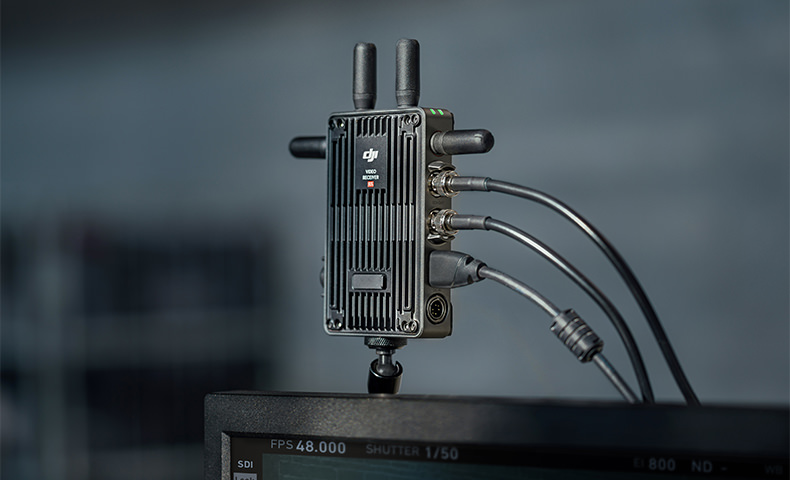
End-to-End Ultra-Low Latency
The video transmitter and receiver use the same chip solution as Ronin 4D, with every link explicitly optimized to provide end-to-end ultra-low transmission latency when pairing with cinema cameras like ALEXA Mini LF.
Seamless Auto Frequency Hopping
O3 Pro adds DFS bands on top of the traditional 2.4 GHz and 5.8 GHz frequency bands, offering up to 23 channel options that provide professional crews with more compliant and interference-free transmission channels. In addition, DJI Transmission supports triple-band automatic frequency hopping, which automatically scans the electromagnetic environment for the best wireless channel.
With a built-in frequency sweeper, users can even manually select the optimal channel to avoid interference between devices.
By mounting high-gain antennas, transmission capability is further boosted.
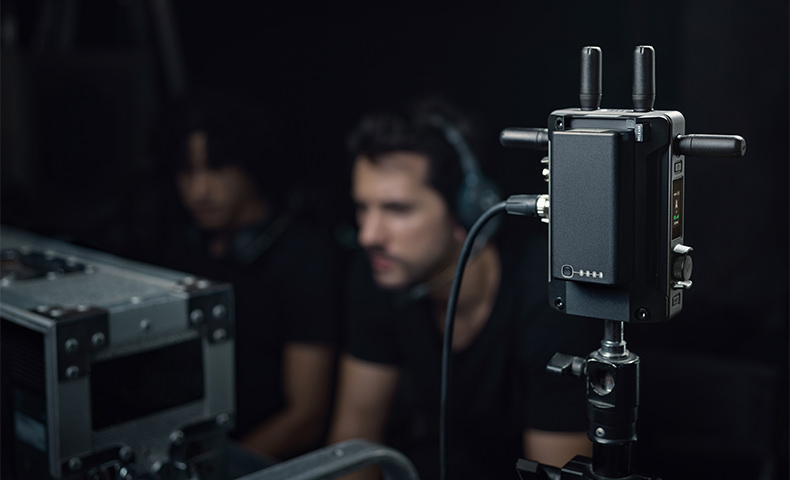
One Transmitter with Multiple Receivers
Both the High-Bright Remote Monitor and the Video Receiver support one transmitter with multiple receivers for video and audio feeds in two transmission modes. The default Broadcast mode allows an unlimited number of receivers, convenient for real-time monitoring by multiple teams such as lighting, art department, and makeup on sets with large crews, and a live feed's bitrate and input feed's video codecs can be displayed in real-time as well. If you want to switch camera index for monitoring, simply select the corresponding index without having to check the transmission channel, which greatly enhances the shooting efficiency.
To connect to DJI Master Wheels or other control devices, select Control mode on the High-Bright Remote Monitor or the Video Receiver and pair it with the Video Transmitter. Then, Ronin 2, RS 3 Pro, and camera focus can all be controlled remotely on up to two receiving ends while not affecting other devices connected via Broadcast mode. In addition, the Video Receiver supports voice calls for real-time, one-on-one, ultra-long-distance voice transmission, providing seamless communication between the cinematographer and the director or client.
Transmission of Metadata
The DJI Video Receiver supports camera metadata transmission via SDI. When used with ARRI, RED, and other mainstream cinema cameras, it can transmit file name, timecode, recording trigger, camera settings (aperture, focal length, etc.), and lens information (aperture, focal length) from the receiver to monitors and QTAKE, allowing directors, cinematographers, and DIT teams to receive detailed shooting information on set.
Encrypted Transmission
DJI Transmission supports secure pairing and AES 256-bit encryption to protect against unauthorized access to your information. Together with DJI’s self-developed chip and transmission protocol, DJI Transmission is able to ensure the highest level of security for your footage.
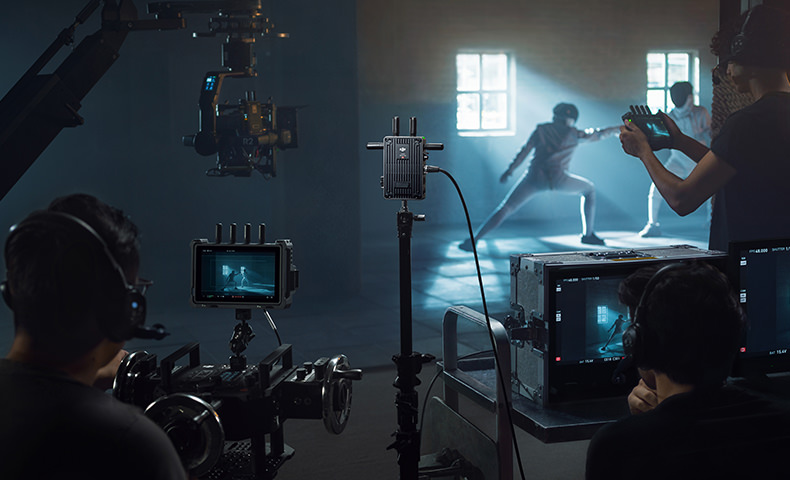
Works with the DJI Ecosystem Expansive Control Options
High-Bright Remote Monitor With Built-In Motion Controller
The High-Bright Remote Monitor has a built-in gyroscopic sensor that enables it to act as a standalone motion controller for Ronin 2 or RS 3 Pro without the need for additional accessories. This allows users to achieve more complex camera movements from a moving vehicle or with a jib.
Compatible with Ronin 4D Hand Grips
The High-Bright Remote Monitor comes with an expansion-protective frame. When using with Ronin 4D Hand Grips, the joystick can control the Ronin 2 or RS 3 Pro gimbal, and the focus wheel can control focusing and the adjustment of camera parameters like aperture, shutter, and ISO, while the record button controls start/stop of recording, making the RS 3 Pro user experience similar to that of Ronin 4D.
Compatible with DJI Master Wheels and DJI Force Pro
Both the Video Receiver and the High-Bright Remote Monitor can be used with DJI Master Wheels, to achieve more advanced gimbal control when using Ronin 2 or RS 3 Pro. In this scenario, the original equipment will transmit control signals directly through DJI Transmission, with no need for additional mounting of antennas on DJI Master Wheels. This boosts the transmission performance by three times and enhances signal range, stability, and anti-interference capabilities.
DJI LiDAR Range Finder (RS) to DJI Transmission Cable Hub
With the DJI LiDAR Range Finder (RS) to DJI Transmission Cable Hub, you can connect the DJI Video Transmitter to the DJI LiDAR Range Finder (RS) and DJI RS Focus Motor (2022) to experience an independent focusing and monitoring system, and achieve lens calibration and autofocus with a manual lens without the need for connecting to RS 3 Pro. Connect it to the Ronin 4D Hand Grips, and you will have LiDAR waveform to facilitate precision manual focusing.
Additionally, when connecting to DJI RS 3 Pro, it gives you an entire set of shooting solutions that integrates stabilization, remote monitoring, gimbal control, and LiDAR focusing.
Mirror Control Mode
When RS 3 Pro is mounted to jibs, cable cams, and vehicles, with Mirror Control mode, you can remotely control the menu of Sony mirrorless cameras from anywhere on set.
%20to%20DJI%20Transmission%20Cable%20Hub.jpg)
All In One Ports and Power Supply
Video Transmitter Ports
3G-SDI Loop Out Port - Supports output of 1080p/60fps videos.
3G-SDI Input Port - Supports input of 1080p/60fps videos.
HDMI 1.4 Type-A Input Port - Supports input of 1080p/60fps videos.
Video Receiver Ports
3G-SDI Output Port - Supports output of 1080p/60fps videos.
HDMI 1.4 Type-A Output Port - Supports output of 1080p/60fps videos.
Direct Power Supply by Gimbal
DJI Transmission can pair with Ronin 2 or RS 3 Pro for a customized shooting solution. The Video Transmitter can be mounted directly to the cold shoe on the bottom of the gimbal and powered by it directly without additional batteries.
Other Power Supply Solutions
WB37 Power Supply
The Video Transmitter, High-Bright Remote Monitor, and the Video Receiver are all compatible with the DJI WB37 Battery.
NP-F Power Supply
The Video Transmitter, High-Bright Remote Monitor, and the Video Receiver can use the included NP-F Battery Adapter to use universal batteries.
V-mount Power Supply
The Video Transmitter, High-Bright Remote Monitor, and the Video Receiver can be powered by V-mount batteries using third-party V-mount battery adapters. Pogo pins on both the front and back of the Video Transmitter and the Video Receiver also allow a simultaneous connection to a V-mount battery plate on a camera via third-party battery adapter for integrated power supply.
DC-IN Power Supply
For a continuous power supply of the Video Transmitter, High-Bright Remote Monitor and the Video Receiver, a P-TAP to DC-IN power cable can be used to connect to an external power source.
20,000ft 1080p/60fps Transmission
Seamless Auto Frequency Hopping
End-to-End Ultra-Low Latency
Integrated Receiver and Monitor
Gimbal/Focus/Camera Control
Independent Recording and Playback
Unlimited Number of Receivers
Transmits Metadata via SDI
Dual-Link SDI + HDMI Simultaneous Output
Product Specifications
Weight: Approx. 350 g (excluding antennas)
Dimensions: 127×87×26 mm (L×W×H, excluding antennas)
Operating Frequency: Frequency Band
Non-DFS Frequency Band:
2.4000-2.4835 GHz
5.150-5.250 GHz
5.725-5.850 GHz
DFS Frequency Band:
5.250-5.350 GHz
5.470-5.725 GHz
5.725-5.850 GHz
In some countries and regions, the 5.1/5.2/5.8 GHz frequencies are prohibited, or the 5.1/5.2 GHz frequencies are only allowed for indoor use. Check local laws and regulations for more information. 5.600-5.650 GHz is not used.
Transmitter Power (EIRP): 2.4000-2.4835 GHz:
<33 dBm (FCC)
<20 dBm (SRRC/CE/MIC)
5.725-5.850 GHz:
<33 dBm (FCC)
<14 dBm (CE)
<23 dBm (SRRC)
Max Bandwidth: 40 MHz
Max Bitrate: 40 Mbps
Power Consumption: 9 W
Power Supply Voltage: 6 to 18 V
Output Voltage: Power output port: 6 to 18 V
Operating Time: 3 hours 50 minutes
Tested in a room temperature of 25° C (77° F) when powered by a fully charged WB37 Intelligent Battery and used with the DJI Video Transmitter.
Output Video Format: With the DJI Video Transmitter:
1080p: 23.98/24/25/29.97/30/50/59.94/60fps
720p: 50/59.94/60fps
With Ronin 4D:
1080p: 24/25/30/48/50/60 fps
Input Audio Format: SDI embedded, HDMI embedded
Output Audio Format: PCM
Video Transmission System: O3 Pro
Video Transmission Latency: 70 ms
Measured when shooting 1080p/60fps video.
Video Coding Format: H.264
Max Transmission Distance: 6 km (FCC)
4 km (CE/SRRC/MIC)
Measured in open environments without obstructions or interference.
Operating Temperature: -10° to 45° C (14° to 113° F)
In the box
DJI Video Transmitter × 1
DJI Video Receiver × 1
WB37 Intelligent Battery × 2
WB37 Battery Charging Hub(USB-C) × 1
RS Gimbal Mounting Plate × 1
WB37 Battery Adapter × 2
NP-F Battery Adapter × 2
DJI Transmission USB-C Power Cable × 1
DC to P-Tap Power Cable × 1
SDI Cable × 1
USB-C Cable × 1
Protector Case × 1
Ronin Video Transmission Antenna × 2
Installation Toolkit × 1
DJI Video Receiver Product Information × 1
WHY BUY FROM US?
By buying from Ferntech, you'll have the confidence that you are dealing directly with New Zealand's leading drone experts. Our staff are knowledgable drone pilots who offer expert advice, trusted support and superior specialist service. Only through us will you receive a full New Zealand warranty, phone and email support, and access to our certified Repairs Centre with DJI-qualified drone technicians. And we guarantee that we will have the best prices on the market — if not let us know and we will match any price (conditions apply).
Warranty Details
General
What status indicators does the DJI Video Transmitter have?
1. The video status indicator shows the status of video signal input:
Solid green indicates there is signal input;
Solid red indicates there is no signal input;
Blinking red indicates there is an error in video input.
2. The linking status indicator shows the status of linking between the transmitter and receiver:
Solid red indicates the device is powered on without linking;
Blinking red and green alternatively indicates that linking is ongoing;
Solid green indicates successful linking or Broadcast mode enabled, and the receiver and transmitter are connected normally;
Blinking red indicates internal error.
Does the DJI High-Bright Remote Monitor support Wi-Fi and Bluetooth?
No.
Does DJI Transmission support third-party antennas?
It is recommended to use standard DJI antennas; otherwise, signal strength may be weaker.
Does DJI Transmission interfere with wireless mics?
When DJI Video Transmission uses the 2.4GHz frequency band, it may interfere with wireless mics. You can switch from auto frequency mode to manual mode and choose DFS channel (vacancy checking is required*) to avoid any conflicts and get better transmission quality.
* In manual mode, checking DFS channel vacancy takes approximately one minute.
Can I use DJI Transmission in low-temperature environments?
The operating temperature range of DJI Transmission is -10° to 45° C (14° to 113° F). DJI Transmission supports multiple power supply options, and using a low-temperature battery delivers better performance in low-temperature environments.
What should I pay attention to when using DJI Transmission in high-temperature environments?
Avoid prolonged exposure to sunlight.
DJI High-Bright Remote Monitor
What is the highest live feed specification that can be transmitted by the HDMI port on the Remote Monitor Expansion Plate? Does it support HDMI input?
It supports transmission at up to 1080p/60fps.
It only supports HDMI output, and not HDMI input. You can input HDMI signals via the HDMI port on the right side of the DJI High-Bright Remote Monitor.
Can the DJI High-Bright Remote Monitor work with third-party video transmitters?
Currently, the DJI High-Bright Remote Monitor only works with the DJI Ronin 4D Video Transmitter, Inspire 3, and the DJI Video Transmitter, and does not support video transmitters of other brands.
How do I enable Mirror Control mode for Sony cameras?
Sony cameras that support BRAVIA Sync (HDMI Control) can use Mirror Control mode. Tap the camera menu icon on the bottom of the DJI High-Bright Remote Monitor to enter the Sony camera menu and remotely control camera settings using virtual buttons on the remote monitor. Before entering Mirror Control mode, enable HDMI Control on the Sony camera. The steps are as follows:
Enter Settings on the Sony camera, enter HDMI Settings, and enable TC Output, REC Control, and HDMI Control. If you don't want to display OSD information of the Sony camera on the DJI High-Bright Remote Monitor, disable HDMI Info.
How do I adjust screen brightness on the DJI High-Bright Remote Monitor?
Tap "…" on the bottom left corner of the DJI High-Bright Remote Monitor. Enter System Settings - General Settings - Screen Settings to adjust screen brightness. The brightness is set to 80% by default.
How do I set the output frame rate of the DJI High-Bright Remote Monitor?
When the DJI High-Bright Remote Monitor is connected to large monitors, you can set the output frame rate of the footage. In Auto mode, the output frame rate is the same as the shooting frame rate. DITs are recommended to use this mode. In Low Latency mode, the output frame rate is fixed at 60fps, and the system latency is the lowest. It is recommended to use this mode in scenarios with latency requirements. The output frame rate can also be customized to 24/25/30/48/50/60fps.
Linking
What are the differences between Monitor A and Monitor B?
Monitor A is the main controller and Monitor B is the sub controller. Both have the same control distance and transmission signal. It is recommended to link the main controller (Monitor A) before the sub controller (Monitor B). If you link the sub control monitor as Monitor B first, you will need to repeat the operation and link it again after linking the main controller (Monitor A) so it can function as sub controller.
In Control mode, how do I trigger linking status for the DJI Video Transmitter?
To link with the DJI High-bright Remote Monitor:
On the DJI High-Bright Remote Monitor, tap Connection Settings and Link to Control Monitor A. On the DJI Video Transmitter, press and hold the menu dial for five seconds to enter linking status. The LINK status indicator will blink red and green alternately. When linking is complete, the LINK status indicator turns solid green and the DJI Video Transmitter can communicate with the High-Bright Remote Monitor.
To link with the DJI Video Receiver:
Press and hold the menu dials on the DJI Video Transmitter and the DJI Video Receiver to enter linking status. The LINK status indicators on both the DJI Video Transmitter and DJI Video Receiver will turn solid green, with prompts on the screens to indicate that linking has been completed.
Is the DJI Video Receiver compatible with Ronin 4D and Inspire 3?
The DJI Video Receiver is currently only compatible with Ronin 4D and the DJI Video Transmitter.
The DJI Video Receiver can link and be used with the DJI Ronin 4D Video Transmitter in Control mode or Broadcast mode. The setup process is as follows:
Press and hold the menu dials on the DJI Ronin 4D Video Transmitter and the DJI Video Receiver to enter linking status. The LINK status indicators on both the DJI Ronin 4D Video Transmitter and the DJI Video Receiver will turn solid green, with prompts on the screens to indicate that linking has been completed.
Where can I find the channel frequency of DJI Transmission?
The information can be found in the channel selection interface on the DJI High-Bright Remote Monitor or in the Channel Frequency Table on the DJI Transmission product page of the DJI official website. For more information, visit: https://www.dji.com/transmission/downloads
Power Supply
Can the DJI Video Transmitter be powered via the USB-C port?
No.
What should I pay attention to when using the DJI Video Transmitter and the DJI Video Receiver with third-party batteries?
When powering video transmission products such as the DJI Video Transmitter or DJI Video Receiver, and other devices (cameras, monitors, etc.,) at the same time with third-party batteries, replace the battery when the battery level is low; otherwise, the unstable power supply may lead to abnormal video transmission.
Can DJI Transmission be powered by DC-IN and battery at the same time?
Once the DC power cable is connected, DC-IN will be prioritized for power supply, and the battery will not output voltage. If the DC power cable is disconnected during power supply, DJI Transmission can seamlessly switch to battery power without interruption.
DJI Video Receiver
How do I use the new voice call function of the DJI Video Receiver?
After linking it with the DJI Video Transmitter in Control mode, set the USB-C function on both the transmitter and receiver to Voice Call. Connect headphones with a built-in mic to the USB-C ports on the transmitter and receiver to enable voice calls.
When the DJI Video Receiver is used with the DJI Video Transmitter, is metadata transmission supported?
Yes. Currently only supports mainstream cinema cameras like ARRI and RED. No settings are required; simply connect to the SDI port for metadata transmission.
Can I use the DJI Video Receiver and the DJI High-Bright Remote Monitor at the same time?
Yes.
What headphone models can I use the voice call feature of the DJI Video Receiver with?
Compatible headphones:
Huawei CM33 (USB Type-C)
NetEase Cloud Music Oxygen Headphones HIFI (USB Type-C)
Edifier H180 Plus (requires 3.5mm adapter)
Xiberia MG-1 (requires 3.5mm adapter)
Samsung Galaxy AKG S10 (requires 3.5mm adapter)
Compatible adapters:
Shanze TY101 Type-C to 3.5mm Adapter
Does the DJI Video Receiver support high-gain antennas?
Yes.
How is the DJI Video Receiver different from the DJI High-Bright Remote Monitor?
The DJI Video Receiver is more suitable for using with third-party remote monitors. Additionally, the DJI Video Receiver can directly output video signals through HDMI or SDI ports without extra expansion modules. Compared with the DJI High-Bright Remote Monitor, the DJI Video Receiver now supports metadata transmission and video output at fractional frame rates, meeting the professional, cinema-grade requirements of large production crews.
Tips
What should I pay attention to when there are multiple camera positions in the setting?
1. Ensure that all DJI Video Transmitters are applying the same broadcast image quality (e.g., all set to HD or Smooth); otherwise, there may be interference issues during use.
2. Avoid using adjacent channels (e.g., use Channel 1, 3, and 5), and it is suggested that the broadcast image quality be set to Smooth on the DJI Video Transmitter to allow for more channels.
What should I do if DJI Transmission interferes with other wireless devices?
1. When using several DJI Video Transmitters or wireless devices (e.g., Inspire 3 remote controller, or audio transmitter or receiver) at the same time, keep a distance of at least one meter between video transmitters and wireless devices to avoid signal interference.
2. When using several DJI Video Transmitters or wireless devices (e.g., Inspire 3 remote controller, or audio transmitter or receiver) at the same time, switch the channel on the video transmitter to DFS channel (users must check vacancy*) to avoid conflict and get better transmission quality.
* In manual mode, checking DFS channel vacancy takes approximately one minute.
How do I improve the anti-interference performance of DJI Transmission?
1. When there are two or fewer DJI Video Transmitters and each transmitter has linked with no more than two receivers, Control mode is recommended with channel mode set to "Auto."
2. When using a DJI High-Bright Remote Monitor, check channel quality on the monitor and prioritize channels with higher green columns and smaller channel numbers. When using a DJI Video Receiver, choose channels marked with a green dot.
3. Avoid using adjacent channels. If there are not enough channels available, select Smooth mode on the DJI Video Transmitter.
4. It is recommended to have all of the DJI Video Transmitters apply the same broadcast image quality (e.g., all set to HD or Smooth).
5. Increase the height of the transmitters and receivers above the ground and place them vertically in relation to the ground.
6. Use high-gain antennas.
What scenarios are recommended for Control mode and Broadcast mode, respectively?
When there are many DJI Video Transmitters in use, it is recommended to use Broadcast mode, which allows for quick switches between different transmitters without limitations on the number of receivers.
If Broadcast mode cannot meet signal requirements, turn off Broadcast mode on the transmitter and enable Control mode. In Control mode, DFS channels are available, which can be used in conjunction with DJI Master Wheels, DJI Three-Channel Follow Focus, and the Ronin 4D Hand Grips. Additionally, with Broadcast mode disabled, Control mode provides extended transmission distance, stronger anti-interference performance, dynamic bitrate adjustments, and seamless auto frequency hopping. When a DJI Video Transmitter is used with a DJI Video Receiver, the voice call function is also available.
(Note: Transmission power is higher in Control mode. Keep a distance of at least one meter between the transmitter and receivers at different positions to avoid interference.)
After enabling Broadcast mode, how do I set the broadcast image quality for optimal video transmission?
When using Broadcast mode, you can set the broadcast image quality on the DJI Video Transmitter according to the scenario requirements to achieve optimal transmission. In HD mode, the transmission bitrate is 40Mb with higher live feed quality but fewer available channels. In Smooth mode, the transmission bitrate is 20Mb with lower video quality but more available channels. When using multiple DJI Video Transmitters simultaneously, if interference occurs, it is recommended to set the broadcast image quality to Smooth mode and avoid using adjacent channels to prevent interference.
There's currently no reviews for this product, be the first to write one.









